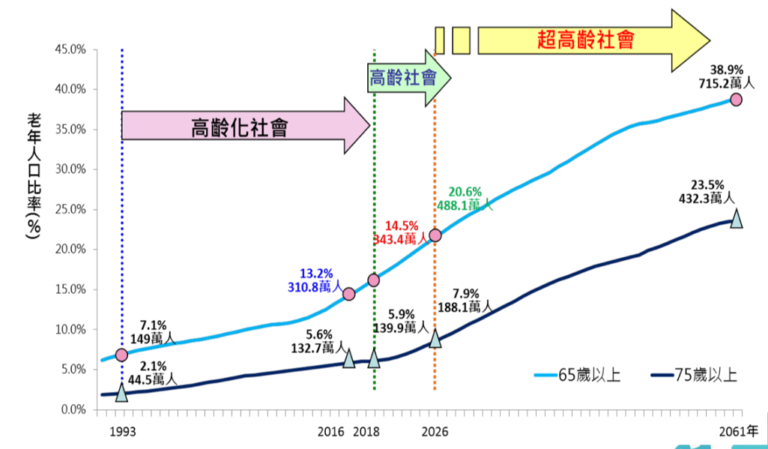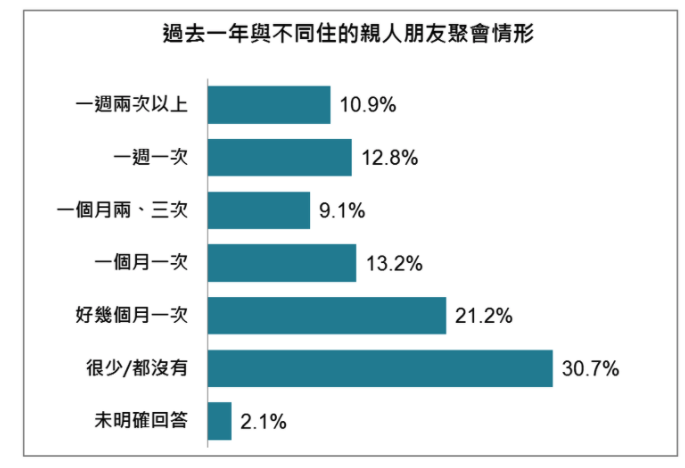With changes in social patterns and many young adults working in other areas, many elderly people in Taiwan are living alone. As Taiwan enters the era of super-aging and living alone, there have been frequent reports of lonely deaths, regardless of age or socioeconomic status, with more and more elderly people taking their last breath in solitude. Some cases involve individuals with children and timely payment of bills, yet they rarely interact with others. In some cases, their bodies may only be discovered days, weeks, or even months later due to decomposition, odor, or body fluid leakage.
The era of “zero caregivers” is approaching.
According to the latest statistics on Taiwan’s elderly population, the number of people over 65 years old has exceeded 3.9 million and is growing rapidly by more than 10,000 people per month. The National Development Council also predicts that Taiwan’s elderly population will exceed 20% and enter the super-aging society by 2025. By 2040, every two young adults will need to care for one elderly person, indicating a reversal of the concept of “family” from a demographic perspective.
Looking at the average household size, in 2020, the average household size in Taiwan was 2.64 people, with single-person households accounting for 34.7% of the total population, and two-person households accounting for 20.5%. This trend has led to the “zero family caregiver” era. In addition, the social structure has changed, and many adult children no longer live with their parents, leaving elderly people vulnerable to being left without care.

Social isolation and weak family ties lead to more lonely elderly than expected
Based on the current data on Taiwan’s elderly population living alone, this generation of older adults is facing the most severe challenges of “aging,” “loneliness,” and “helplessness.”
According to statistics from the Ministry of the Interior, there are currently over one million households in Taiwan with elderly people living alone or being cared for by the elderly. Among them, 24.6% of those aged 85 and above live alone, 22.4% of those aged 75 to 84 live alone, and 21.9% of those aged 65 to 74 live alone.
In addition, according to the Ministry of the Interior’s housing data statistics, the number of homes occupied by elderly people has reached 6,271,167 this year, doubling from 3,300,000 homes 10 years ago. Among them, the number of homes with only one elderly person living alone is as high as 477,066, accounting for 76.07%.
The Chinese Elderly Welfare Promotion Alliance’s statistics for this year (2021) show that 1.92 million elderly people in Taiwan have met with different relatives or friends less than once a month in the past year, with 30.7% reporting “rarely or never” having such meetings, indicating that there are many people in today’s society who experience family relationship estrangement.
Secretary-General Zhang Shu-qing of the Elderly Welfare Alliance pointed out that after retirement, the elderly lose their connection with society. If they do not socialize outside their homes, their decline will accelerate. “Living old and lonely without a sense of security and confidence is a warning sign.” According to the Elderly Welfare Alliance’s statistics, there are 2.07 million elderly people in Taiwan who are willing to continue working, but 1.97 million believe that young people generally underestimate the contribution of the elderly, and 940,000 elderly people have felt lonely for years.

When relying on family is not feasible for aging care, can we depend on the government?
According to the Ministry of Health and Welfare’s registry of elderly individuals in need of care, there are only about 42,300 people listed this year, accounting for approximately 1% of the total elderly population in Taiwan. In reality, many elderly individuals who live alone and require assistance are difficult to identify.
The trend of aging and living alone in Taiwan is difficult to reverse, and there is concern about the implementation of the Long-term Care 2.0 policy. The Social Welfare and Environmental Hygiene Committee of the Legislative Yuan held a public hearing on “Long-term Care 2.0 Overall Review and Long-term Care Service Law Amendment” today, inviting the Ministry of Health and Welfare, the Ministry of Labor, and relevant experts and scholars to attend.
In the meeting, Vice Minister of Health and Welfare Xue Rui-yuan mentioned that Long-term Care 2.0 has been implemented since 2017. Although the coverage rate of long-term care services has been gradually increasing, as of October of this year, the number of users of long-term care services reached 376,275 people, an increase of 8.6% from the previous year, accounting for 55.38%. In recent years, resources have focused on “community-based integrated care service systems,” encouraging the elderly to participate in community activities and achieving a reach rate of about 60% for home-based service units and day care centers.
However, most of these programs are aimed at “independently living individuals with adequate life skills” or elderly individuals with “at least one fixed caregiver.”
Chen Jing-ning pointed out that the average duration of a care process is 9.9 years, with approximately 80% of individuals having mild to moderate disabilities and approximately 20% having severe disabilities. Although the coverage rate of Long-term Care 2.0 has exceeded half of the elderly population, individuals with severe needs have difficulty meeting the related requirements, including those who reside in long-term care facilities, which only provide a monthly subsidy of NT$5,000, placing a heavy burden on families. Additionally, more than 30% of families in Taiwan with long-term care needs rely on foreign caregivers who often operate outside the system.
Chang Shu-ching also stated that long-term care units in various counties and cities are disorganized, and the personnel are often temporary. Long-term Care 2.0 is based on project-based subsidies, and the fragmented and residual payment methods make it difficult for caregiver families to receive support. The speed of elderly policies cannot keep up with the speed of Taiwan’s aging population.
Regarding financial resources, the Long-term Care Fund has also increased 36 times since 2017. However, due to limited financial growth, it has been in deficit since last year, and it is estimated to be short by NT$10 billion this year, posing a hidden worry for social welfare policies for long-term care.
Recently, legislators from both the ruling and opposition parties and civil groups have proposed legislation to address long-term care issues, including the implementation of a “Long-term Care Arrangement Leave” to support caregivers, and the inclusion of caregiver support centers in the social welfare system, hoping to create a long-term care-friendly community and prevent elderly individuals from falling into the dilemma of having no one to care for them and no social opportunities.
文章來源: This Week Magazine/Xiao Tingfang
